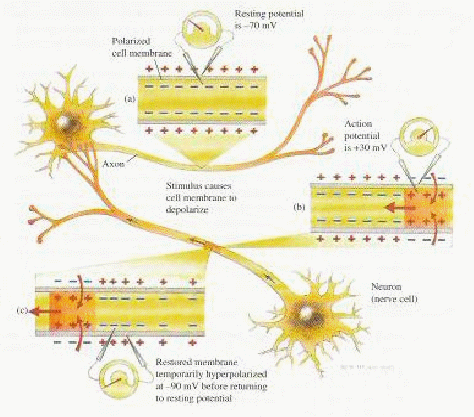Physiological Effects of Electric Currents
Electrical potential differences and electric currents play a vital role in the nervous systems of animals. Conduction of nerve impulses is basically an electrical process, although the mechanism of conduction is more complex than in conductors. A nerve fibre or axon, along which an electrical impulse can travel has a cylindrical membrane with one conducting fluid inside and another outside. In the resting condition the only charged bodies that can cross the membrane are positively charged potassium ions which leak out of the axon into the surroundings. This leaves the inside of the axon with a net negative charge and a potential of about 0.07 V with respect to the outer fluid – diagram (a) below.

When an electrical stimulus is applied to the axon, the membrane temporarily becomes more permeable to other ions in the fluids, leading to a local change in potential difference. This disturbance, called the action potential, propagates along the membrane as a pulse with a speed of about 30 m/s. The entire pulse passes a given point along the axon in a few milliseconds, after which the membrane recovers and the potential difference returns to it's initial value.
The electrical nature of nerve impulses explains why the body is sensitive to electric current. Currents as small as 0.1 A can be fatal because they interfere with essential nerve processes such as those in the heart. A current of 0.01 A through an arm or leg can cause convulsions and pain, and a person can find themselves unable to release a conducting that is passing them a current of 0.02 A. Currents of this magnitude can cause ventricular fibrillation. The heart twitches, pumping very little blood. Strangely, a larger current is less likely to do this and can start the heart beating again when supplied via an electric defibrillator.
Body fluids are usually good conductors because of their high ion concentrations. The resistance of skin is higher –![]() This means that low voltages are usually quite safe.
This means that low voltages are usually quite safe.